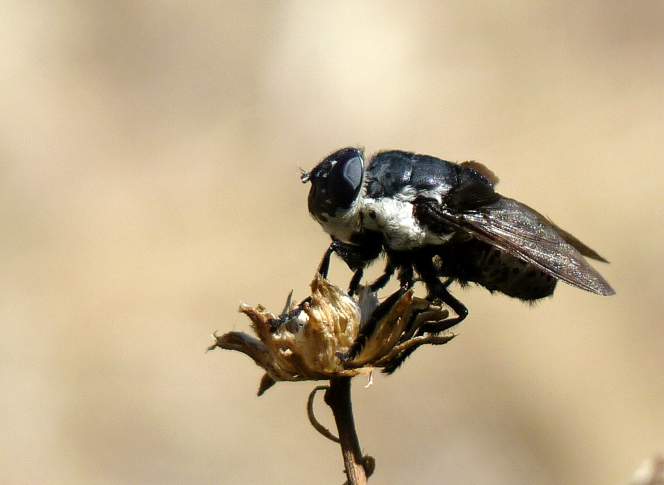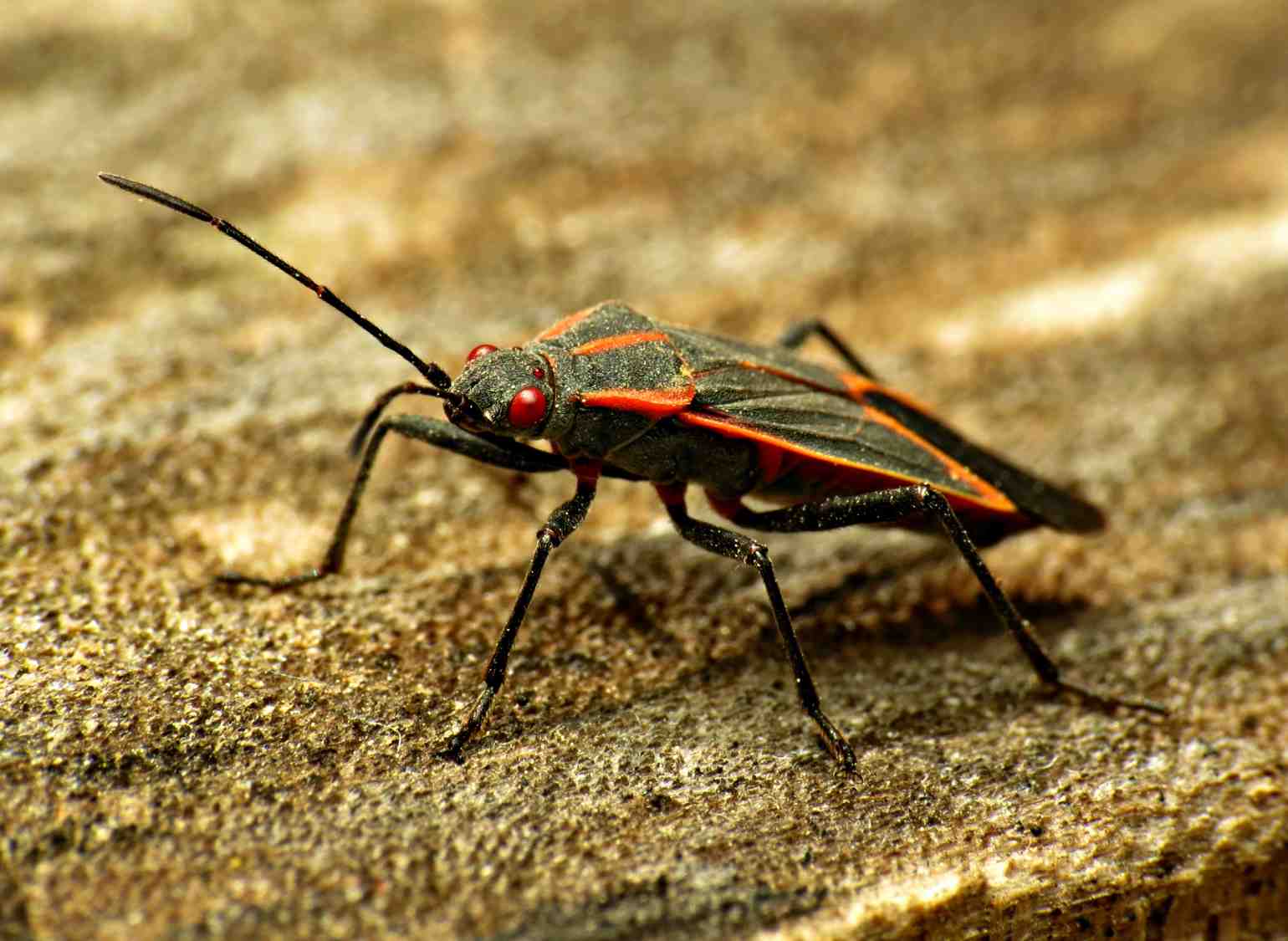The Top 10 Wisconsin Insect Trends Of 2016
With the first green shoots of spring appearing across the state, Wisconsin's insect populations are likewise emerging and preparing for the warmer months ahead.
April 6, 2017

Rodent bot fly on flower

With the first green shoots of spring appearing across the state, Wisconsin’s insect populations are likewise emerging and preparing for the warmer months ahead. The top 10 insect trends of 2016 encountered by the University of Wisconsin Insect Diagnostic Lab offers insight on which bugs might make an impression in 2017. While most of the insects on the list are relatively benign, some might put a damper on an afternoon picnic while others could ruin an entire day.
10. Boxelder bugs
Many insects, including mosquitoes and fungus gnats, thrived in Wisconsin’s rainy conditions in 2016. However, heavy rains can also be a blessing in disguise when it comes to certain insect pests. Gypsy moth caterpillars, for example, can be killed off by the entomopathogenic fungus Entomophaga maimaiga under damp conditions. Heavy spring rains over the past few years likely encouraged this fungus, which helped keep gypsy moth numbers low in many parts of the state.
Rainy conditions can also encourage a fungal disease of boxelder bugs. With rainy conditions across much of Wisconsin, boxelder bug populations were expected to be low, but disease pressure from the fungus was likely limited in 2016. Much to the chagrin of homeowners hoping to avoid the tiny red-and-black home visitors in the fall, boxelder bug numbers were surprisingly high in many parts of the state. Rainfall will likely influence the boxelder bug situation in 2017.
9. Scale insects
Scale insects are truly bizarre creatures. For example, the magnolia scale can look more like a fungus than an actual insect. As in 2015, many reports of scale insects came into the UW Insect Diagnostic Lab over 2016, especially during the spring and summer months. The most commonly encountered type was the lecanium scale, which can blend in on twigs and resemble deformed plant buds. Both magnolia and lecanium scales produce copious amounts of sticky, messy honeydew, which can attract ants and wasps, and lead to the growth of black sooty mold.
In many cases, scale insects can be notoriously difficult to control. Luckily, over time there are a number of natural enemies (tiny parasitic wasps) that help bring outbreaks under control. With two consecutive years of high scale insect populations, 2017 might finally be the year that the natural enemies help bring the situation under control.
8. Brown marmorated stink bug
Reports of the brown marmorated stink bug in 2016 were very similar to those in 2015. Dozens of sightings of this relatively new invasive species were reported, mostly from the southern part of Wisconsin. Madison and the surrounding Dane County region continue to be the hot spot of BMSB activity in the state, with additional activity in Milwaukee and Waukesha metro area and the Fox River Valley. A few counties had their first confirmed reports of BMSB in 2016: Sauk and Columbia, both north of Madison.
Of particular interest were the first reports of these insects on plants — previous reports involved insects overwintering in buildings. In addition, some of the first observations of juveniles and mating adults occurred in the state. Those reports confirm that the brown marmorated stink bug is breeding in Wisconsin and is likely to continue to increase its numbers in the future. This insect is expected to be a concern for vegetable growers, fruit growers, and home gardeners in the coming years.
7. Giant silk moths
Some of the Midwest’s largest insects, giant silk moths, had a big year in 2016. Wisconsin is home to a number of giant silk moth species, including the cecropia moth, polyphemus moth, imperial moth, promethea moth and the ever-so-elegant luna moth.
Historically, these sizable moths, with a wingspan of 4-5 inches or more, used to be more common in many parts of the country, although their numbers seem to have declined over time. This may be partly due to landscape/habitat changes, urbanization and accompanying light pollution, with parasites likely to be a key factor in this situation. The parasitic fly Compsilura concinnata, originally imported to control pest caterpillars such as the invasive gypsy moth, also happens to attack and kill a number of wild silk moth caterpillars and can have significant impacts on their populations. However, numerous reports coming in to the UW Insect Diagnostic Lab indicated that giant silk moth numbers might have been up in 2016 compared to the past few years. Only time will tell what the silk moth populations do in the state in 2017.
6. Fungus gnats
Many Wisconsinites may have noticed plagues of tiny, dark-colored flies in backyards in late summer and fall. Spurred by the rainy conditions, fungus gnats were extremely abundant in many parts of the state in 2016. As larvae, fungus gnats live in damp, decaying organic materials: rich soil, decaying plants, compost piles and similar materials. Fungus gnats themselves are harmless and don’t bite, but could have been a minor nuisance in the backyard.
In many cases, fungus gnats were also spotted indoors in fall 2016. In those situations, the fungus gnat larvae could have easily been living in the damp soil of potted plants brought indoors for the winter months. If overwatering of indoor plants continued, the fungus gnats persisted indoors as well.
5. Metallic wood boring beetles
Two different metallic wood boring beetles (Family Buprestidae) had strong seasons in 2016. The first, the invasive emerald ash borer, is no stranger to Wisconsinites in recent years. While there were only three new counties — Portage, Wood and Sawyer — added to the state quarantine map in 2016, there were over 80 municipalities with their first confirmed emerald ash borer infestation last year, out of 227 municipalities with documented finds at the end of December. That said, the emerald ash borer has greatly picked up steam these past few years and is attacking ash trees at a rapid rate across the Midwest.
Another metallic wood borer that seemed to have a good year was the twolined chestnut borer. Unlike the invasive emerald ash borer, the twolined chestnut borer is native to North America and tends to attack stressed oak trees. In these cases, trees might be stressed by factors such as disease, drought stress, winter injury or damage from other insects, making them susceptible to the twolined chestnut borer. The UW Insect Diagnostic Lab noticed a distinct increase in cases of the twolined chestnut borer in summer 2016, although the underlying stress might have begun affecting trees several years ago. With the high value of oak trees in the landscape, this insect is definitely a pest that tree care companies should have on their radar for the near future.
4. Home-invading weevils
Many Wisconsinites experience or at least are familiar with insects that sneak indoors in the fall, such as boxelder bugs and multicolored Asian lady beetles. There’s also a group of broad-nosed weevils that happen to sneak indoors during the summer months. Species in this group include the strawberry root weevil, the imported long-horned weevil and others.
Once indoors, these weevils tend to stumble around in a slow, somewhat tick-like manner, causing concern to homeowners. But fear no weevil, for these insects are completely harmless. A broom or vacuum cleaner are often the best tools to deal with them. While broad nosed weevils can be somewhat common, reports coming in to the UW Insect Diagnostic Lab suggest that numbers of these home-invading beetles were up in 2016.
3. Scarab beetles
A number of scarab beetles had noteworthy activity in 2016, including several important landscape pests. Scarab beetles can be an extremely common group of insects, with well over 100 species in Wisconsin alone. Perhaps the best known, and most infamous member of this group would be the Japanese beetle (Popillia japonica), which seemed to rebound in 2016 after a few quiet years. In parts of the state with sandy soil, the rose chafer was present in high and damaging numbers. Similar to Japanese beetles, rose chafers are fond of feeding on a wide range of plants from landscape shrubs to fruit trees.
Two other scarab beetles were noteworthy in 2016: the Northern masked chafer and the European chafer. It was the first year that larvae of these beetles (white grubs) had been found damaging turfgrass in the state: Rock County (Northern masked) and Door County (European). Previously, turfgrass managers only had to contend with the white grubs of Japanese beetle and the occasional beetle in May or June. Wisconsin will most likely see more of these newer white grub species in the state in coming years.
2. Bot flies
Bot flies are not for the faint of heart, especially for anybody about to eat! For those unfamiliar with bot flies, these creatures may seem like something out of a science fiction movie.
In their simplest terms, bot fly larvae are essentially large, flesh-inhabiting maggots. When fully mature, the maggots can be over an inch long and are covered with tiny backward-facing spines, making removal nearly impossible from their host. Adult bot flies are very short-lived and somewhat resemble bumble bees or certain horse flies in their size and coloration.
In a typical year, the UW Insect Diagnostic Lab might receive one or two reports of these insects. For whatever reason, bot flies had a great year in 2016 and several dozen reports came in to the lab of rodent bot flies.
The common species observed in Wisconsin in 2016 were from the genus Cuterebra, and parasitize small mammals such as mice, chipmunks, squirrels and rabbits. The maggots live and feed beneath the skin of their mammal host for weeks before popping out to pupate. The mammal hosts generally seem to tolerate their companions, although the concept of bot flies may give a creepy-crawly feeling. Luckily, the bot flies seen in the state last year don’t utilize humans as a host. However, the human bot fly (Dermatobia hominis) native to South and Central America can make that tropical vacation an unforgettable experience.
1. Mosquitoes
With all the stories about the Zika virus in the news, it was difficult to avoid hearing about mosquitoes in 2016. In addition, with the heavy rains many parts of Wisconsin received, it was equally challenging to venture outdoors and avoid mosquitoes. In many parts of the state, mosquito pressure was severe in 2016, giving mosquitoes the top spot on the year’s list. If there’s a silver lining to this mosquito presence, it has three parts:
- The mosquitoes that were dreadfully abundant (floodwater mosquitoes) aren’t important vectors of human disease. Yes, they might have ruined that evening cookout, but at least they weren’t making anyone ill.
- Reports of mosquito-borne diseases (such as West Nile Virus) were relatively low in Wisconsin in 2016.
- Zika virus was not a major issue in Wisconsin, as the mosquito species responsible for that disease haven’t been found in the state.
Mosquito populations are difficult to predict and can be heavily influenced by weather patterns. Precipitation this spring and summer will ultimately have the biggest influence in making or breaking 2017’s mosquito populations.
University of Wisconsin-Extension entomologist PJ Liesch is director of the University of Wisconsin-Madison Insect Diagnostic Lab. He blogs about Wisconsin insects and can be found @WiBugGuy on Twitter.
 Passport
Passport





















Follow Us